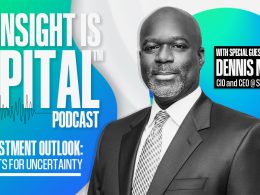Key takeaways
- If historical precedent holds up, there is still room to be positive on equities as we move into 2019 and on to early 2020.
- The key is to identify companies that can gain market share from technology-enabled advantages in their business model or disruptive shifts in consumer behavior.
- We highlight several areas where technology is enabling disruption and creating opportunities.
As we look forward into 2019, we believe there is continued potential for positive US equity returns, but slowing economic growth may mean more frequent downhills — and more investors losing their way — than during the market’s climb of recent years. Observing the weight of the evidence, we have moved into a late-cycle environment. In our view, the path forward will not rely on choosing growth versus value, or small-cap versus large-cap. We believe it will rely on identifying “share-takers” (companies that can gain market share from technology-enabled advantages in their business model and in consumer behavior) and avoiding “share-losers” (companies that have simply been buoyed in recent years by the expanding economic environment).
Late cycle, but maybe longer cycle too
While we are late in the cycle, economic data has continued to look positive and we are not seeing imminent signs of a downturn. The gloomy macro headlines of late 2018 are not materially different from those that we saw earlier in this nine-year run, and yet US stocks are up over 400% since March 2009.1 In fact, the economy remains quite healthy, and if historical precedent holds up, there is still room to be positive on equities as we move into 2019 and on to early 2020. The previous two secular bull markets (1942-1966 and 1982-2000) lasted 18 and 24 years respectively, and delivered over 1000% returns off the prior market lows.2
Slowing growth and the biggest risk we see today
Our base case expectation is for slowing growth over the next 12 to 18 months. The positive benefits of US tax stimulus and deregulation are being offset by higher interest rates, rising labor costs and trade pressures. While we see a natural deceleration in growth, we do not believe recession is imminent.
The biggest risk to this view is a misstep in Federal Reserve (Fed) monetary policy. Today, we believe the US Federal Reserve (Fed) is walking a knife’s edge: It is balancing expected economic data and the inertia of its telegraphed rate path against the unknowable impacts of tax reform benefits and the lagged impact of relatively quick successive rate hikes. If the Fed tightens too quickly, higher interest expense could drive corporate earnings growth lower and possibly drive the economy into a recession by materially increasing business and personal financing costs, at the same time that cyclical growth is naturally slowing.
The path forward: Identifying ‘share-takers’
In such an environment, true growth will likely become an even scarcer commodity, and thus we believe the market will continue to favor companies that can produce growth and compound earnings in spite of the economic cycle. We believe that change is the fuel for growth, and that today is a compelling time to invest in share-takers, because it is a period of massive change, and market share is shifting rapidly between companies. Consumer habits and business models are rapidly changing with the introduction of new technology. Historically, it has been rare — almost unheard of — to capture shifts that are global in nature (versus regional or market-specific) over a typical investment horizon. But today, technology is removing the barriers for global commerce. In our view, these changes are producing winners and losers, and creating an excellent environment for bottom-up fundamental research and stock picking — the keystone of our investment process on the US Growth Equities Team.
Here are several areas where technology is enabling disruption and creating opportunities:
- Connectivity/mobile devices. Mobile devices are driving an inflection point in internet connectivity; the developed market is spending more time online, and the emerging market is gaining access to the internet for the first time, thereby changing consumer behavior in both markets. We estimate that over 4 billion people have access to the Internet globally, and we expect that another 1.3 billion people will gain Internet access over the next three years.3
- Artificial Intelligence. In the health care sector alone, AI-enabled advancements such as robot-assisted surgery, virtual nursing assistants, workflow management, fraud detection, and dosage error reduction have the potential to save $150 billion in costs by 2026.4
- E-Commerce. E-commerce is at a point of inflection as it begins to penetrate the largest commerce verticals of food, consumables and auto. E-commerce accounts for just 12% of retail spending today, and we believe this could accelerate to more than 30% in the next few years as additional categories are on the verge of moving online, including food and food service, consumables, auto and auto parts, furniture, appliances and luxury goods — all of which currently have low e-commerce penetration.5
- Digital music. The digital music industry is shifting from a single-serve distribution model to a subscription model — which we believe is the ideal way to capture value.
- 53% of millennials spend over three hours a day listening to music.6
- Streaming music revenue has grown more than 40% year-over-year for the last five years. 6
- Streaming of digital music has created an inflection point, returning the music industry to growth after years of decline. 6
- Online advertising. Online advertising spend is still catching up to traditional media advertising spend, and has room for continued long-term growth.
- Mobile devices and personal computers account for 57% of media time spent by US adults,7 while online advertising represents only 44% of ad budgets.8 Online advertising is taking share from traditional print, radio and television advertising.
- Video games. Video game companies are well-positioned to expand their market and margins through more downloadable content, increasing mobile graphics processing power and eSports momentum.
- The current market of 500 million gaming consoles is driving video game revenues and profit margins with direct-to-consumer downloadable games and upgrades.9
- Smartphone graphics processing power has just reached the level of the previous video game console generation, thereby unlocking years of video game library content to a total addressable market of over three billion smartphones. 9
- Genomics. The cost of sequencing a human genome has declined significantly from $100 million in 2001 to under $1000 in 2017, opening the door for broad and rapid diagnosis and treatment of disease.10
This post was originally published at Invesco Canada Blog
Copyright © Invesco Canada Blog
















